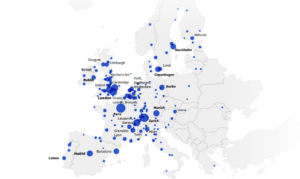Startups & Spin-offs: Assessing The Risk of Entering a New Market

When you as a startup or a corporate spin-off start operations, you’re entering a new ecosystem. An ecosystem in this sense is the aggregation of companies, institutions and other players inevitably connected through their shared goal or mission. Depending on the nature of your business, it could be local, global or even both. But one thing’s constant: any ecosystem is full of unknowns and insecurities.
For that reason, you want to be able to estimate the risk and the chances of being successful with the given resources and the competition in that ecosystem. And you want to do it upfront, right?
There are several ways to achieve that, but the best and most effective of these is talking. Having genuine conversations with potential stakeholders to see if they’re really aligned towards the same goals can help prevent failure. To facilitate that, we’d like to introduce you to an easy framework that allows startups and also corporate spin-offs to keep track of conversations and to determine their position within the ecosystem they want to enter.
Value Blueprints: Getting an overview of your ecosystem
We recommend Ron Adner’s ‘Value Blueprints’ to help you see the bigger picture. They help you find the right players to talk to and then to assess the risk when it comes to collaborating with them. For the purpose of analyzing the entry into an entrepreneurship ecosystem, we’ve extended the blueprints to include competitive and non-competitive players, as well as players with a good overview of the ecosystem itself.
To map out your blueprints, first, you have to define your end customer. This is always the player that ultimately benefits from the service/product provided. Next, map out the suppliers – the players you need to create value. Then come intermediaries – the players standing between you and the end customer. Finally you map the complementors or those who smooth the intermediaries’ path to the customer.
That done, you add players with a good overview of the ecosystem, as well as competitive and non-competitive players. Once they are on the blueprint, the outcome should look like the following graphic.

How to assess the risk
There are two questions which you should always ask yourself: “Are they able to perform the task I need them to?” (co-innovation risk) and “Are they also willing to perform the task needed?” (co-adoption risk). To be able to answer those questions before entering an ecosystem is crucial, because agreeing on the vision inside of an ecosystem does not necessarily mean agreeing on the way to reach it. If all players’ strategies are heading towards collaboration, they also partly assume underlying structures.
Therefore, a system using traffic light colors has been developed in order to best rate and visualize the risk within the ecosystem. Green lights mean “We’re good to go,” a yellow light means “They can’t do it yet,” or “They don’t want to do it yet,” and a red light means “No way this will work.” It’s important to mention that a few yellow lights at the beginning are no major problem and can be solved by coming up with various incentives to turn them green. Red lights, however, can represent major issues, meaning that you might have to find another player to fill that gap or even change the business model. In the following graphic, the blueprints are extended by said traffic lights.

The process and outcome
Let’s pretend you own an online bookstore, ready to launch. Before drawing the blueprints for the first time, the players with a good overview about the specific ecosystem, as well as competitive and non-competitive players, have to be approached to find the gap in the existing ecosystem. Competitive players would be other services like Amazon and physical bookstores. Non-competitive players would be platforms which offer complementary goods to your customers.
After doing that and knowing where to start, you have to come up with a structure of the value blueprints (image 1) and assess the risk with the help of the traffic lights (image 2). Suppliers, in this case, could be publishers and IT infrastructure services. Intermediaries are resellers of your bookstore and complementors are delivery services. Last, the risk of collaboration has to be assessed as described.
After the first sketch, chances are that some alterations might be needed to the blueprints. So you sit down, adjust them according to the feedback and validate again and again and again…
These value blueprints could be perceived as rather unusual, especially for managers in bigger corporations, because they involve a lot of upfront conversations and agreements with outside parties. However, the “we’ll talk about that later in the process,” approach is just not appropriate and justifiable in a complex ecosystem and can eventually lead to major problems on the way.
We suggest modifying the notion of “If we build it, will they come?” and instead ask, “If we build it, how will they get here?”
And if the answer is “We’re not sure,” you definitely want to know that before you commit your resources!
Alexander Schuh is currently working at Pioneers Discover as Innovation Consultant, fostering startup – corporate collaboration. Besides that, he works as a Network Developer at the Entrepreneurship Ecosystem Research Network. If you are interested in the article or in the general topic of collaboration and ecosystems, feel free to get in touch with him via social media or via e-mail.



























